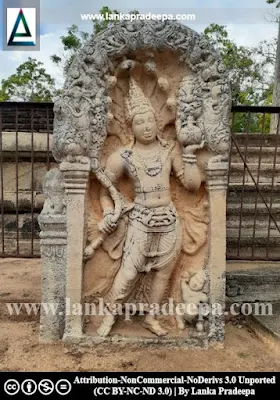
Ratnaprasada is an ancient Uposathagara (a chapter house) located in Abhayagiri Monastery in Anuradhapura, Sri Lanka (Jayasuriya, 2016; Nicholas, 1963). It is considered the largest building found in the monastery complex (Wikramagamage, 2004).
History
Ratnaprasada was the Uposathagara where the monks of Abhayagiriya monastery gathered twice per month to confess and rectify their mistakes by reciting the Pratimoksha (according to the Bhikkhu discipline). It is the corresponding building to the Lohapasada of Maha Viharaya and Diyasen Paya of Jetavana Monastery (Nicholas, 1963).
The original chapter house was built at the present site by King Kanitthatissa (164-192 A.D.) in the 2nd century A.D. (Jayasuriya, 2016; Nicholas, 1963; Wikramagamage, 2004). It was enlarged by King Mahinda II (787-807 A.D.) but plundered by the Pandyans in the 9th century A.D. (Jayasuriya, 2016; Nicholas, 1963; Wikramagamage, 2004). The ransacked building was restored by King Sena II [(853-887 A.D.) Jayasuriya, 2016; Nicholas, 1963; Wikramagamage, 2004]. The 10th-century Abhayagiri inscription reveals that at the time the Ratnaprasada building was seen as a five-storied mansion. Also, the Anuradhapura inscription of King Kassapa V (913-923 A.D.) and Abhayagiri Slab Inscriptions of Mahinda IV (956-972 A.D.) have called this building "Ruvana-paha" or "Ruvan-maha-paha" (Wickremasinghe, 1912).
The present structure has been dated by archaeologists to the 7-8th century A.D (Jayasuriya, 2016). However, the excavations have revealed the remains of the 2nd-century foundation below the present building which according to the beliefs, is the remains of the original chapter house constructed by Kannitthatissa.
Muragala/the guard stone
The Muragala (the guard stone) found on the left of the entrance of the Ratnaprasada building is considered the most artistic guard stone found in Sri Lanka (Jayasuriya, 2016; Wikramagamage, 2004). The guard stone is dominated by the sculpture of the Naga-king who is holding a Purnaghata (a pot of abundance) in his left hand. The right hand of the Naga-king carries a bunch of flowers representing prosperity (Jayasuriya, 2016). At the feet of his left leg is a small figure of a dwarf. Above the Naga-king is a round-shaped arch in which two Makara (dragons) with open mouths can be seen on either side of the arch. The figures of two couples of lovers emerge from the mouth of these two dragons. These dragons and lovers, according to the view of some, may represent an idea related to fertility and prosperity. However, according to another view, this reminds us that indulgence in worldly life is like entering the mouth of a dragon (Jayasuriya, 2016).
This artefact has been dated to a period between 7-9 centuries A.D.
 .
.
References
1) Jayasuriya, E., 2016. A guide to the Cultural Triangle of Sri Lanka. Central Cultural Fund. ISBN: 978-955-613-312-7. pp.26-27.
2) Nicholas, C. W., 1963. Historical topography of ancient and medieval
Ceylon. Journal of the Ceylon Branch of the Royal Asiatic Society, New
Series (Vol VI). Special Number: Colombo. Royal Asiatic Society (Ceylon
Branch). p.143.
3) Wikramagamage, C., 2004. Heritage of Rajarata: Major natural, cultural, and historic sites. Colombo. Central Bank of Sri Lanka. p.104.
4) Wickremasinghe, D.M.D.Z., 1912. Epigraphia Zeylanica: Being lithic and other inscription of Ceylon (Vol. I). London. Archaeological
Survey of Ceylon. pp.55,225,239.
Location Map
This page was last updated on 14 January 2023
A short note for local school students
රත්න ප්රාසාදය
ශ්රී ලංකාවේ අනුරාධපුර පිහිටි අභයගිරි විහාරයට අයත් පුරාණ උපෝසතාගාරය (පොහොය ගෙය) රත්න ප්රාසාදය යනුවෙන් හැඳින්වේ.
ඉතිහාසයඅභයගිරිවාසී භික්ෂූන් විසින් මසකට දෙවරක් රැස්ව ප්රාතිමෝක්ෂය කියවා තම වැරදි නිවැරදි කරගත් ස්ථානය මෙය වෙයි.
මෙහි මුල්ම ඉදිකිරීම 2වන සියවසේදී කණ්ට්ඨතිස්ස රජු (ක්රි.ව. 164-192) විසින් කරවන ලදී. IIවන මහින්ද රජු (ක්රි.ව. 787-807) විසින් ගොඩනැගිල්ල විශාල කරවනු ලැබුවත් 9වන සියවසේදී පාණ්ඩයන් එය කොල්ලකන ලදී. කොල්ලකන ලද පොහොය ගෙය IIවන සේන රජු (ක්රි.ව. 866-901) විසින් ප්රතිසංස්කරණය කරන ලදී. දහවන සියවසට අයත් අභයගිරිය ශිලා ලිපියකට අනූව රත්න ප්රාසාදය මහල් පහකින් යුක්තව තිබී ඇත.පුරාවිද්යාඥයින් විසින් වත්මන් ඉදිකිරීම 7-8 සියවස් වලට අයත්යැයි කාල නිර්ණය කොට තිබේ. කෙසේනමුදු, මෙම ස්ථානයේ කරන ලද කැණීම් වලදී වත්මන් ගොඩනැගිල්ලට යටින්, කණ්ට්ඨතිස්ස රජු විසින් ඉදිකලා යැයි විශ්වාස කෙරෙන ක්රි.ව. 2වන සියවසට අයත් පාදමක නටඹුන් හමුව ඇත.මුරගලරත්න ප්රාසාදයට ඇතුළු වන දොරටුව වම්පස දක්නට ලැබෙන මුරගල ශ්රී ලංකාවේ කලාත්මකම මුරගල ලෙස හැඳින්වේ. එහි වම් අතින් පුන්කලසක්ද, දකුණතින් මල් මිටියක්ද දරා සිටින නාගරාජ රුව සශ්රීකත්වය නියෝජනය කරයි. නාගරාජ රුවට ඉහලින් වූ මකර හිස් ද්විත්වයෙන් පිටවන පෙම් යුවල යුගල විසින් ප්රජනනයත් ඒමගින් සස්රීකත්වයත් දක්වන බවට අදහසක් වෙයි. නමුදු තවත් අදහසකට අනූව ඉන් හැඟවෙන්නේ ලෞකික සුව විඳීම යනු මකර කටකට යෑමක් වැනිය යන්නයි.
මෙම මුරගල 7-9 සියවස් අතරට අයත් නිර්මාණයක් යැයි විශ්වාස කෙරේ.


